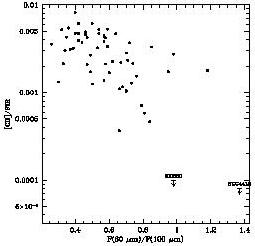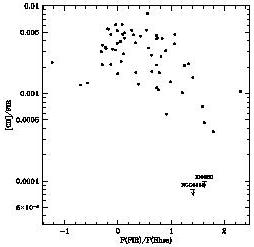


Far-infrared fine structure lines, especially
[CII]  157.7µm and
[OI]
157.7µm and
[OI]  63.2 µm,
have long been used for estimating density and radiation intensity in
photo-dissociation regions (PDR) (e.g.
Hollenbach & Tielens
1997).
ISO has provided for this topic a wealth of data, whose interpretation is
creating controversy and challenging theoretical models.
Malhotra et al. (1997)
showed that while two thirds of normal galaxies have
63.2 µm,
have long been used for estimating density and radiation intensity in
photo-dissociation regions (PDR) (e.g.
Hollenbach & Tielens
1997).
ISO has provided for this topic a wealth of data, whose interpretation is
creating controversy and challenging theoretical models.
Malhotra et al. (1997)
showed that while two thirds of normal galaxies have
 (CII) /
(CII) /
 (FIR) in the range 2-7 x
10-3, this ratio
decreases on average as the 60-to-100 or the
(FIR) in the range 2-7 x
10-3, this ratio
decreases on average as the 60-to-100 or the
 (FIR) /
(FIR) /
 (B) ratios increase, both indicating
more active star formation
(Figure 3). They linked this decrease
to elevated heating intensities, which ionize grains and thereby reduce the
photo-electric yield.
(B) ratios increase, both indicating
more active star formation
(Figure 3). They linked this decrease
to elevated heating intensities, which ionize grains and thereby reduce the
photo-electric yield.

| 
|
Figure 3. The CII deficiency in active star forming galaxies from Malhotra et al. (1997). | |
The same CII deficiency is also observed in ultra-luminous infrared
galaxies (Fischer et
al. 1999;
Luhman et al. 1998),
who favor optical depth
effects as the origin of the effect. This is hard to reconcile however
with a similar deficiency effect occurring for
[NII]  121.9 µm
as well, but not for
[OI]
121.9 µm
as well, but not for
[OI]  63.2µm.
Detailed discussion is found in
Malhotra et al. 1999,
Fischer et al. 1999, or
Luhman et al. 1999.
63.2µm.
Detailed discussion is found in
Malhotra et al. 1999,
Fischer et al. 1999, or
Luhman et al. 1999.